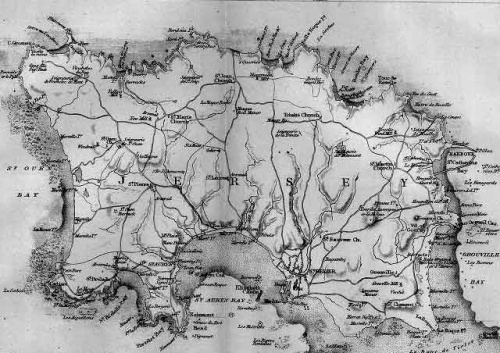Preface
The following little Work is in Three Parts, with headings to the different Chapters for the facility of reference, a plan, which it is hoped will be found advantageous.
The First Part (from Page 1 to 86), is an abridged History of Jersey, compiled from the best historians, mixed with original matter, and continued to the present time. The want of a cheap and accessible edition of this kind had long been felt as a desideratum.
The Second Part (from Page 87 to 167), is mostly confined to a Description of the Town of St Helier, and its contiguous maritime, and military establishments. The author avails himself of this opportunity to acknowledge the valuable information he has received from his venerable friend, the learned M de Gerville, the French antiquary of Valognes, on the ecclesiastical antiquities of this Island.
The Third Part (from Page 168 to 254) consists of a Tour, in Six Chapters, to visit the most interesting localities in Jersey. It is an original selection, rather than a compilation from Ouless' Scenic Beauty of Jersey, published a few years ago, the Explanations and Descriptions of which were written by the author of this Work, for which he now solicits the patronage of the Public.
A certain part of the materials had never appeared before ; the rest is a compilation, which, though it has been selected from the best authorities, can have no claims to originality. This always happens, when the novelty of the subject has already been long exhausted, by its previous appearance in numerous publications. It is therefore only by something new in the style, or by some particular arrangement of the matter, that an old subject can be placed in a more striking point of view, and have the merit of being made more interesting to the Reader.
After this candid acknowledgment, it would be superfluous to crowd the following pages with marginal references to the numerous authorities, which it has been advisable to consult in the course of preparing this Publication.
The strictest impartiality has been observed, throughout, so as to speak of men and things, as if every prejudice had been removed by the distance of some centuries from the actors in those busy scenes; but at the same time to shrink from no statements, which can be established by facts, and to profess no opinions either inconsistent with the purest loyalty to our Sovereign, or at variance with the warmest attachment of Jerseymen to their native island, or to the well-being and the permanency of its local interests.
- St Helier's, Jersey
- 18 June 1847
Introduction
- Situation of the Channel Islands, and of Jersey in particular.
- Its proximity to the coast of France.
- Its conformation and general appearance.
- The fertility of its soil, and its abundant supply of fresh water.
In a deep bay on the coast of Normandy, which takes its name from the far-famed monastic and chivalrous Abbey of Mount St Michael [Mont St Michel], at an easy distance from the continent, lies a group of small but fertile islands, which now form the only feeble, but interesting remnant of the ancient Duchy of Normandy, but which is now better known by the general name of the Channel Islands. These consist of Jersey, Guernsey, Alderney, and Sark, with some smaller ones of little importance. Of all these, Jersey is the largest, the most populous, and the nearest to the coast of France; it has also the most considerable proportion of fruitful and cultivated land.
These islands are further highly favoured in point of situation and latitude, lying open on one side of the British Channel, and in one of the mildest portions of the temperate zone. St Michael's Bay forms an extensive curve, which recedes to a considerable distance into the French coast, and sweeps on from Cap La Hague in Normandy, to Cape Frehelle in Brittany. The whole of that long range of coast is commanded in time of war by the naval forces of Great Britain, which are stationed at those islands.
Jersey lies the most southerly of this group, and as this little work is particularly intended to assist strangers in their excursions there, it will be unnecessary to say any thing further about its sister islands.
Position
We may therefore begin by observing that Jersey is situated in 49 degrees of North latitude, and 2 degrees 22 minutes West longitude of London. Geographically speaking it cannot be denied that it forms a very approximate appendage of the French continent, the nearest points of which are not at the distance of more than five or six leagues. These are the small fishing towns of Carteret and Portbail, from the latter of which the Jersey markets receive a plentiful supply of provisions. The sea in the intermediate channel is shallow, and as there is a tradition that Jersey, at some distant period, was, by some violent commotion or other separated from the continent, if such an event did ever happen, it was probably at that place.
It is at the eastern end of Jersey, where the sea leaves dry at low water a ridge of low rocks, of sand banks and of shingle, about three miles in length, which is well-known by the local name of the 'Bank du Violet', near the extremity of which, and on a higher rock, Seymour Tower was built about 60 years ago. It was from that point that it was found, on actual soundings not many years back, that the water in the middle of that channel is not more than 40 feet at low water, and about 80 feet at full tide. How frail then, yet how extraordinary a barrier is this, which has kept two nations distinct from each other in their manners, their laws, and their religion for almost a thousand years!
The other French ports in the neighbourhood of Jersey are Granville, at the distance of 10 leagues, and those of St Malo and Cherbourg, at the distance of about 12 leagues each; the latter of which has of late years become a formidable naval establishment, which in case of any future war with France would require to be watched by Great Britain with particular vigilance.
In reckoning the distances to the nearest British possessions, they are as follows:
- To Guernsey, about seven leagues.
- To Alderney, about ten leagues.
- To Weymouth, about 25 leagues.
- To the Isle of Wight, about 30 leagues
- To Southampton, about 40 leagues
The island's structure
The form of the Island is that of an irregular parallogram, running from south-east to north-west. Its greatest length is about 12 miles, and the average breadth may be estimated at full 5 miles, but in no part does it exceed 7 miles. It has been ascertained by a recent survey that its surface contains from 39,000 to 40,000 acres. From this total must of course be deducted some tracts of sandy downs and rocky coasts, with a few other waste lands only adapted to the growth of wood or furze.
The appearance of Jersey is that of an inclined plane towards the south. The same conformation is also observable with some exceptions of high and rugged tracts of coast on its western and eastern boundaries. Part of the eastern coast, commencing at Mount Orgueil, and the whole of the northern shore as far as l'Etac, in St Ouen's parish, form, with but few interruptions, a range of cliffs rising abruptly from the sea to the height of from 200 to 300 feet. This natural defence renders the island in those places nearly inaccessible.
The internal rocks are in general mere naked ridges, forming here and there promontories projecting into the sea, a circumstance which adds to the rapidity of the tides and currents, and varies their courses. In several places the rocks are loosely blended with other stony substances, or are in a state of great disintegration. Hence the violence of the tides has formed some deep inlets, and scooped out several caverns, where occasionally, in such confined situations, the water rises to the perpendicular height of 40 or 50 feet, whence the spray is dashed about in every possible direction. It is at a narrow interval from these rugged cliffs that the land begins to decline towards the southern coast, which in several places is nearly on a level with the sea.
The slip of table land, which runs parallel between the northern and southern coasts, and from which the waters flow towards either, is on an average not above a mile wide. In this respect Jersey displays a striking contrast with Guernsey, the southern boundary of which shoots up into high rocks from the water, and declines towards the north. It is principally owing to this difference of position that there is such a marked variety in the nature of the soil, and in the temperature of the atmosphere in the two islands, which considering the small distance between them, would otherwise be inexplicable.
In general the strata of the rocks run from north to south, thus following the form of the island; but those layers are usually more inclined than the declination of the surface. No part of the island rises to an elevation of more than from 200 to 300 feet, the highest localities of which are tracts of table land, gradually sloping towards the sea, particularly on the southern coast. Those elevated parts are at small distances from each other, and intersected by deep, and in general by narrow vales, which run from north to south. The sides of those vales are bounded by steep and sometimes even craggy declivities; but more frequently they are planted with timber, or thickly set with furze and brushwood.
Those slopes are generally too steep to be cultivated to advantage, and are therefore left in their unproductive state. At the highest elevation of those slopes begins the table land, to which they seem to serve as embankments to prevent it from falling into those vales. Under this point of view, the country presents as it were an appearance of hills, which had been truncated and compressed to form the irregular surface of that table land. These numerous vales have copious rivulets of water, which run through them, when they again receive the accession of an infinite number of tributary streams which flow into them from a thousand springs. On which account there is not perhaps any spot in the world which is more bountifully supplied with fresh water.
The comparatively long course of those rivulets is particularly advantageous to so small an island, as it enables it to have a greater number of watermills, than it would have been possible to erect under different circumstances.
- A thousand springs gush from the adjacent hills
- And pour their waters thro' embow'ring groves
- And grassy meads, in fertilising rills
- While as the eye along the landscape roves,
- With rapid glance, a living picture moves;
- Of happiness in each secluded vale,
- Where dwells a num'rous race, where labour proves,
- That frugal food and pleasure shall not fail,
- While health is in the clime, and coolness in the gale.
| Previous | Next | |
| 1847 guidebook | Preface and introduction | History - Chapter 1 |


